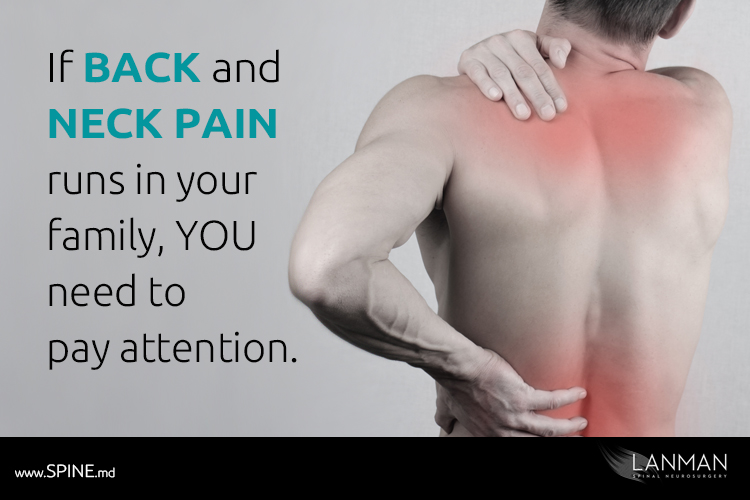If it runs in your family, that’s nature’s sign that you need to pay attention.
You can’t stop degenerative disc disease, especially if it runs in your family. I’ve seen patients as young as their teens who eventually need surgery. But I also see patients who are well into their 80s experiencing chronic back and neck pain for the first time in their lives.
Don’t get me wrong. Degenerative disc disease is so commonplace that, in my opinion, it defies genetics. However, there is data that demonstrates that we could be born with a predisposition for certain types of symptomatic spinal disorders (like disc degeneration that leads to herniation). What the data in a study conducted in 2011 (and others going back to 2008), if we have certain spine disorders, more than likely someone in our family also had the same problem.
My only problem with some of these ‘umbrella’ studies of this type is that we often do not adequately compare other data points such as socio-economics and demography of the family members included in the analysis. For instance, what are the impacts of high-risk occupational activity? What about physical inactivity that may also run in the family?
I once knew a family of avid softball players who handed down a generational tradition for softball. This tradition included a specific aggressive style of swinging a bat for a homerun that was started by “Granny” back in the 1950s. Apparently, the woman invented the technique well before she was “granny.” I treated three generations of successive sons and daughters for lumbar herniations due to these repeat hyperflexions and hyperrroatations very similar to golfers. Some families take their bat swinging very seriously.
Yes, disc herniations may run in families. It’s just as likely that types of physical activity (occupational or leisure) may also encourage spinal disorders. However, no matter your genetic disposition, the surest way to accelerate degenerative disc disease is with inactivity.
In my opinion, as a doctor and seeing hundreds of patients at my office in Beverly Hills, CA, if the last time you visited a gym was when you were in high school or college, you have the highest risk for degenerative disc disease, despite the fact that your entire family has never had one herniated disc. Your risk for chronic back and neck problems is even higher than that family of softballers. You ask, “how can that happen?” How can sitting around in a comfortable office chair all day increase your risk for a herniated disc?
It’s not so hard to imagine when you understand how the spine works. Remember that the spine is very complicated both in function and its purpose. It is a column of bones—called vertebra—held together with semi-flexible discs (that cushion the vertebra). The spine is the central load-bearing structure of the skeleton assisted by cartilage, tendons, and muscle. This is where you find the major anchor points for just about every muscle you use to stand up and walk. Even sitting in a chair requires the coordination of several muscle groups to maintain balance and functionality.
Inactivity leads to atrophy (weakening) of the same muscle groups that are so important for daily living. When they are sufficiently weakened, more and more of the work is placed on other elements in the structure like the discs I mentioned earlier. As unhealthy inactivity weakens the muscles, more and more support stresses are forced onto those discs. All you need is a sudden sneeze to trigger a herniation.
Some back and neck patients are surprised by how little effort it takes to reduce the risk for further damage to their spine: just a daily walk of 1 or 2 miles will help reduce some of the risk. While a daily walk around the block is better than nothing, I recommend a more aggressive approach. For my patients, a proactive program for spine health includes cardio-balance exercises (especially for men) and light weight exercises (especially for women). You don’t have to be a bodybuilder to stave off back and neck pain. You can start with 20 minutes of exercise per day, but the more, the better. Up to an hour, if you’re really just getting started.
Here’s the biggest tip of all. If you have a family history for any disease, that’s nature’s way of telling you that you need to get checked out by a physician. It’s just common sense. It’s also important to remember that those neck and shoulder aches you’ve had for most of your adult life could be the first sign that you have a developing cervical herniation. Detected and treated early increases the range of non-invasive treatment modalities that your doctor can prescribe (e.g., physical therapy, outpatient surgery). Caught early enough, some patients push surgical solutions off for years.
But you won’t know until you call your doctor.
LINKED SOURCE: American Academy of Orthopaedic Surgeons. “Lower back disease may be in your genes: New study indicates predisposition to lumbar disc disease could be inherited.” ScienceDaily. ScienceDaily, 2 February 2011. Link: https://www.sciencedaily.com/releases/2011/02/110202143804.htm







